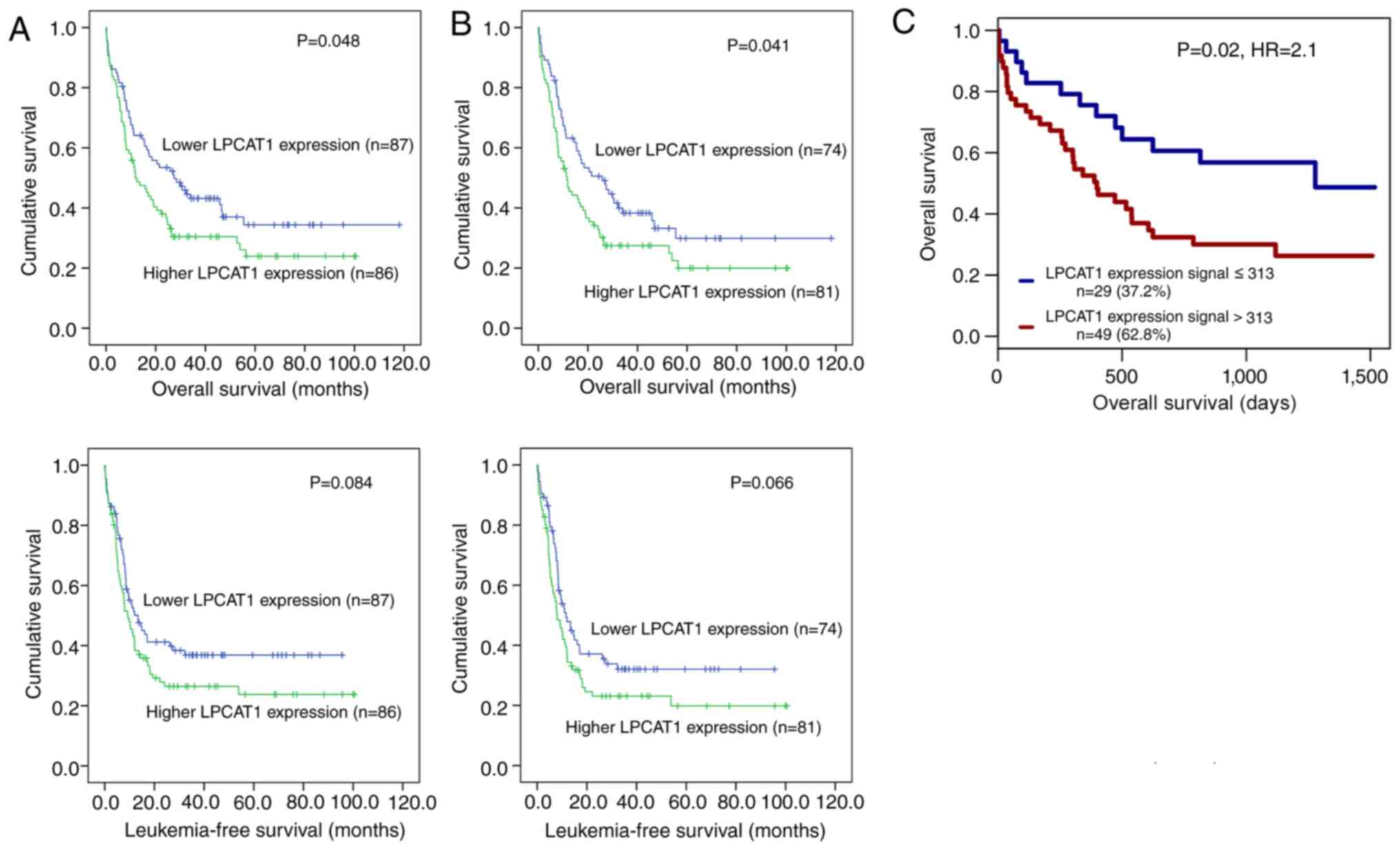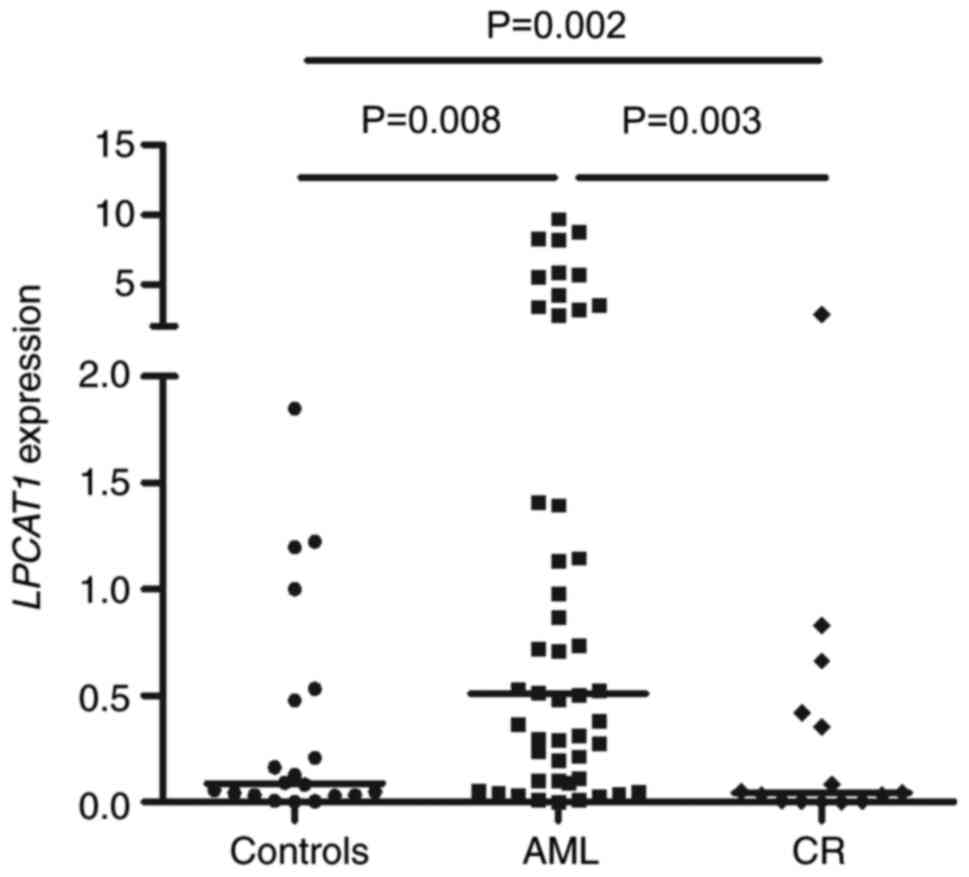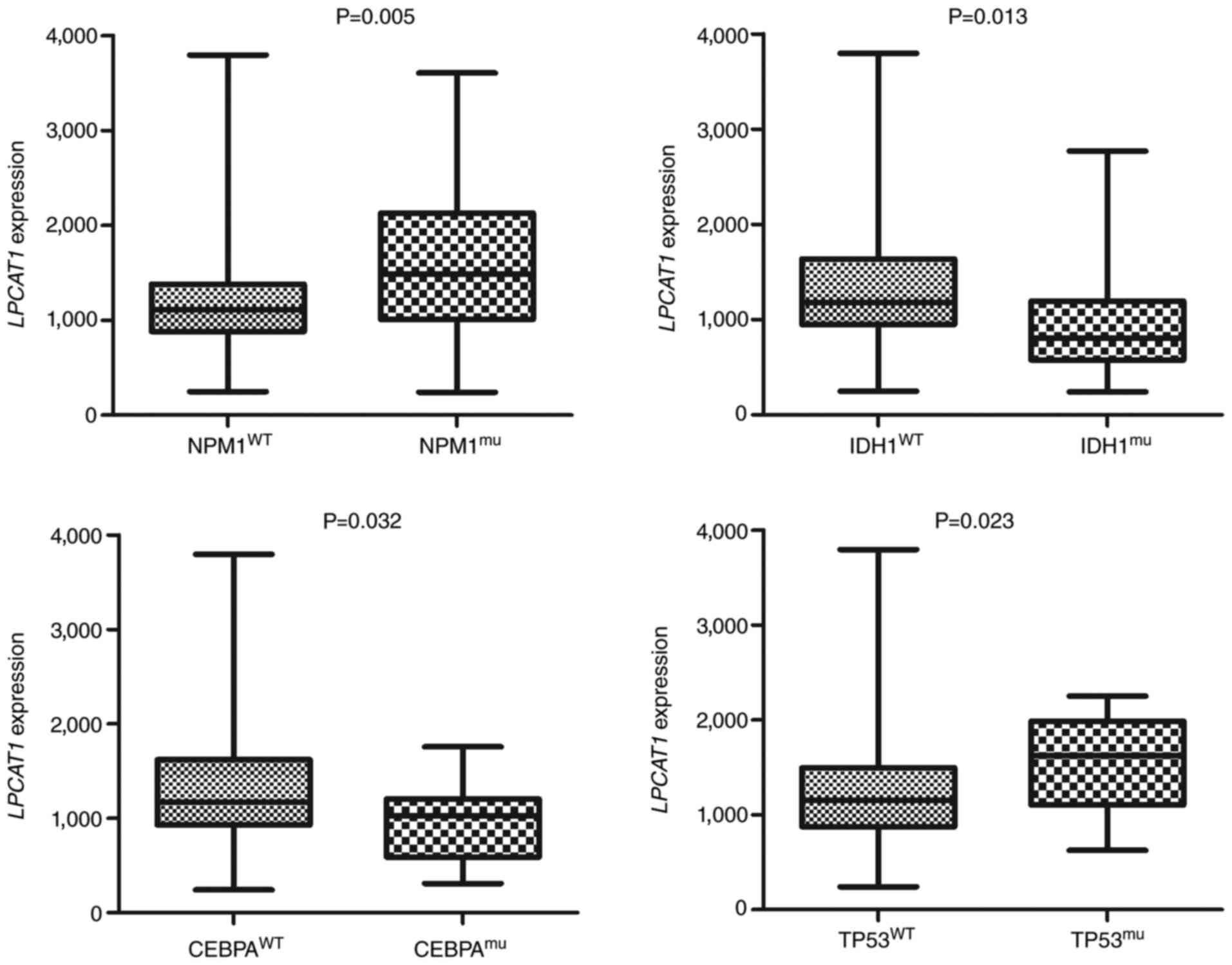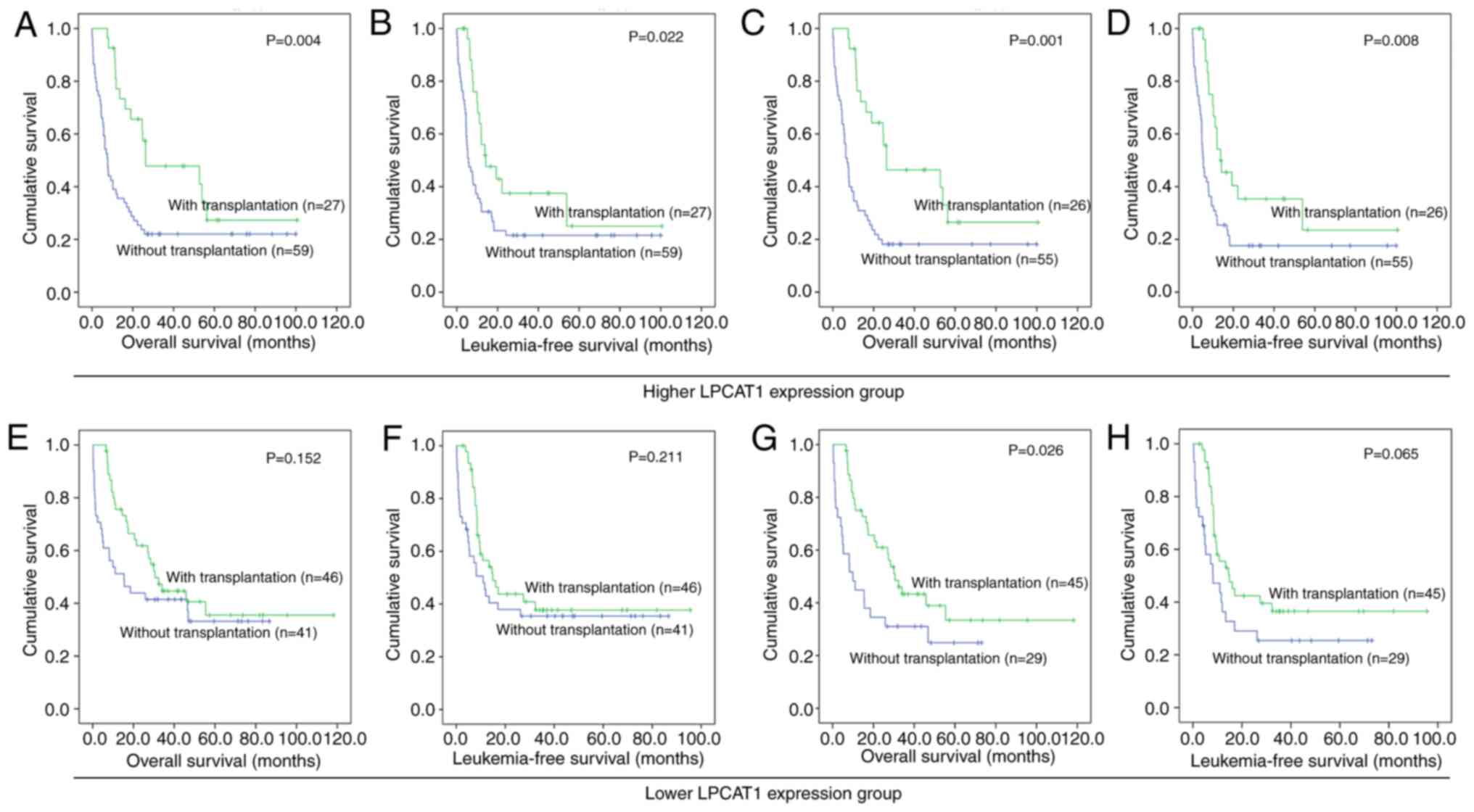|
1
|
Estey E and Döhner H: Acute myeloid
leukaemia. Lancet. 368:1894–1907. 2006. View Article : Google Scholar : PubMed/NCBI
|
|
2
|
Döhner H, Estey E, Grimwade D, Amadori S,
Appelbaum FR, Büchner T, Dombret H, Ebert BL, Fenaux P, Larson RA,
et al: Diagnosis and management of AML in adults: 2017 ELN
recommendations from an international expert panel. Blood.
129:424–447. 2017. View Article : Google Scholar : PubMed/NCBI
|
|
3
|
Santos CR and Schulze A: Lipid metabolism
in cancer. FEBS J. 279:2610–2623. 2012. View Article : Google Scholar : PubMed/NCBI
|
|
4
|
Law SH, Chan ML, Marathe GK, Parveen F,
Chen CH and Ke LY: An updated review of lysophosphatidylcholine
metabolism in human diseases. Int J Mol Sci. 20:11492019.
View Article : Google Scholar
|
|
5
|
Zhou X, Lawrence TJ, He Z, Pound CR, Mao J
and Bigler SA: The expression level of lysophosphatidylcholine
acyltransferase 1 (LPCAT1) correlates to the progression of
prostate cancer. Exp Mol Pathol. 92:105–110. 2012. View Article : Google Scholar : PubMed/NCBI
|
|
6
|
Grupp K, Sanader S, Sirma H, Simon R, Koop
C, Prien K, Hube-Magg C, Salomon G, Graefen M, Heinzer H, et al:
High lysophosphatidylcholine acyltransferase 1 expression
independently predicts high risk for biochemical recurrence in
prostate cancers. Mol Oncol. 7:1001–1011. 2013. View Article : Google Scholar : PubMed/NCBI
|
|
7
|
Lebok P, von Hassel A, Meiners J,
Hube-Magg C, Simon R, Höflmayer D, Hinsch A, Dum D, Fraune C, Göbel
C, et al: Up-regulation of lysophosphatidylcholine acyltransferase
1 (LPCAT1) is linked to poor prognosis in breast cancer. Aging
(Albany NY). 11:7796–7804. 2019. View Article : Google Scholar : PubMed/NCBI
|
|
8
|
Abdelzaher E and Mostafa MF:
Lysophosphatidylcholine acyltransferase 1 (LPCAT1) upregulation in
breast carcinoma contributes to tumor progression and predicts
early tumor recurrence. Tumour Biol. 36:5473–5483. 2015. View Article : Google Scholar : PubMed/NCBI
|
|
9
|
Uehara T, Kikuchi H, Miyazaki S, Iino I,
Setoguchi T, Hiramatsu Y, Ohta M, Kamiya K, Morita Y, Tanaka H, et
al: Overexpression of lysophosphatidylcholine acyltransferase 1 and
concomitant lipid alterations in gastric cancer. Ann Surg Oncol. 23
(Suppl 2):S206–S213. 2016. View Article : Google Scholar : PubMed/NCBI
|
|
10
|
Du Y, Wang Q, Zhang X, Wang X, Qin C,
Sheng Z, Yin H, Jiang C, Li J and Xu T: Lysophosphatidylcholine
acyltransferase 1 upregulation and concomitant phospholipid
alterations in clear cell renal cell carcinoma. J Exp Clin Cancer
Res. 36:662017. View Article : Google Scholar : PubMed/NCBI
|
|
11
|
Wei C and Dong X, Lu H, Tong F, Chen L,
Zhang R, Dong J, Hu Y, Wu G and Dong X: LPCAT1 promotes brain
metastasis of lung adenocarcinoma by up-regulating PI3K/AKT/MYC
pathway. J Exp Clin Cancer Res. 38:952019. View Article : Google Scholar : PubMed/NCBI
|
|
12
|
Morita Y, Sakaguchi T, Ikegami K,
Goto-Inoue N, Hayasaka T, Hang VT, Tanaka H, Harada T, Shibasaki Y,
Suzuki A, et al: Lysophosphatidylcholine acyltransferase 1 altered
phospholipid composition and regulated hepatoma progression. J
Hepatol. 59:292–299. 2013. View Article : Google Scholar : PubMed/NCBI
|
|
13
|
Shida-Sakazume T, Endo-Sakamoto Y, Unozawa
M, Fukumoto C, Shimada K, Kasamatsu A, Ogawara K, Yokoe H, Shiiba
M, Tanzawa H and Uzawa K: Lysophosphatidylcholine acyltransferase1
overexpression promotes oral squamous cell carcinoma progression
via enhanced biosynthesis of platelet-activating factor. PLoS One.
10:e01201432015. View Article : Google Scholar : PubMed/NCBI
|
|
14
|
Mansilla F, da Costa KA, Wang S, Kruhøffer
M, Lewin TM, Orntoft TF, Coleman RA and Birkenkamp-Demtröder K:
Lysophosphatidylcholine acyltransferase 1 (LPCAT1) overexpression
in human colorectal cancer. J Mol Med (Berl). 87:85–97. 2009.
View Article : Google Scholar : PubMed/NCBI
|
|
15
|
Cancer Genome Atlas Research Network, ;
Ley TJ, Miller C, Ding L, Raphael BJ, Mungall AJ, Robertson A,
Hoadley K, Triche TJ Jr, Laird PW, et al: Genomic and epigenomic
landscapes of adult de novo acute myeloid leukemia. N Engl J Med.
368:2059–2074. 2013. View Article : Google Scholar : PubMed/NCBI
|
|
16
|
Metzeler KH, Hummel M, Bloomfield CD,
Spiekermann K, Braess J, Sauerland MC, Heinecke A, Radmacher M,
Marcucci G, Whitman SP, et al: An 86-probe-set gene-expression
signature predicts survival in cytogenetically normal acute myeloid
leukemia. Blood. 112:4193–4201. 2008. View Article : Google Scholar : PubMed/NCBI
|
|
17
|
Kassambara A, Rème T, Jourdan M, Fest T,
Hose D, Tarte K and Klein B: GenomicScape: An easy-to-use web tool
for gene expression data analysis. Application to investigate the
molecular events in the differentiation of B cells into plasma
cells. PLoS Comput Biol. 11:e10040772015. View Article : Google Scholar : PubMed/NCBI
|
|
18
|
Bennett JM, Catovsky D, Daniel MT,
Flandrin G, Galton DA, Gralnick HR and Sultan C: Proposed revised
criteria for the classification of acute myeloid leukaemia. A
report of the French-American-British Cooperative Group. Ann Intern
Med. 103:620–625. 1985. View Article : Google Scholar : PubMed/NCBI
|
|
19
|
Arber DA, Orazi A, Hasserjian R, Thiele J,
Borowitz MJ, Le Beau MM, Bloomfield CD, Cazzola M and Vardiman JW:
The 2016 revision to the World Health Organization classification
of myeloid neoplasms and acute leukemia. Blood. 127:2391–2405.
2016. View Article : Google Scholar : PubMed/NCBI
|
|
20
|
Livak KJ and Schmittgen TD: Analysis of
relative gene expression data using real-time quantitative PCR and
the 2(-Delta Delta C(T))method. Methods. 25:402–408. 2001.
View Article : Google Scholar : PubMed/NCBI
|
|
21
|
Falini B, Brunetti L, Sportoletti P and
Martelli MP: NPM1-mutated acute myeloid leukemia: From bench to
bedside. Blood. 136:1707–1721. 2020. View Article : Google Scholar : PubMed/NCBI
|


















